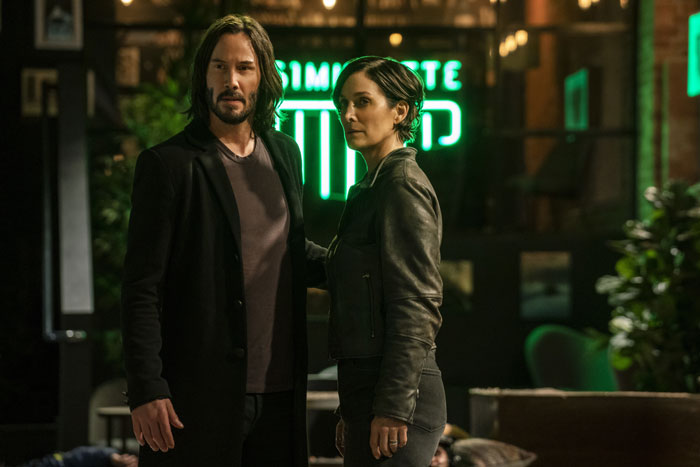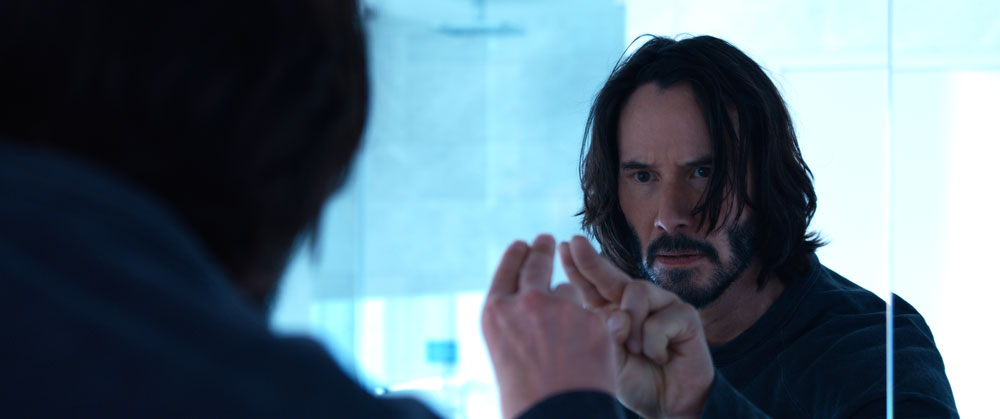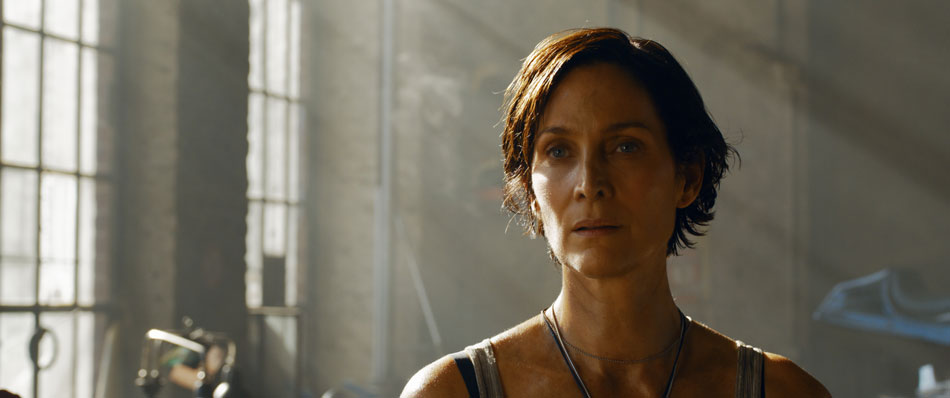Beyond publishing an entire magazine – we also publish stories exclusively to the Backstory blog and hope you’ll continue to check back for more articles and reviews.
We recently published our huge issue #45, our winter issue with a Dune cover and you can see our ever-changing table of contents right here. We say ever changing because we often continue to add new articles into the magazine after we publish – which is the beauty of a digital magazine.
If you’ve never read Backstory Magazine before you can test-drive us by reading our free issue!
If you dig what we do, we hope you’ll consider becoming a subscriber to Backstory and get access to our new content and our archive by subscribing right here.
Thanks for considering supporting independent film journalism and spreading the word and we hope you enjoy the article!
Current Cinema
The Matrix Resurrections: The Editor
By Jeff Goldsmith and David Somerset
Joseph Jett Sally has always worked well with Lana and Lilly Wachowski, even crediting them with at least a few techniques he employs today, picked up through the shared experiences of filming the likes of Speed Racer and, particularly, Ninja Assassin. “That film was interesting because they did a lot of rewriting, and we did a lot of ADR [automated dialogue replacement],” the editor says. “The lightbulb went off about how much you could bend a story or a film with well-placed ADR and recutting. Not all films need it, of course, but it was fun to see. And I’m always learning with them. They’re very, very smart filmmakers.” Lest one assume Sally is any sort of a newbie needing to hone his skills, he’s been cutting films as an assistant, editor and visual-effects editor since the early 1990s, working on an incredible variety of productions ranging from low-budget thrillers to the Star Wars prequels. Still, the writing-directing siblings clearly saw something special in him, as he went from assistant on Racer to full-fledged editor (alongside Giancarlo Ganziano) on Assassin, directed by longtime Wachowski second-unit colleague James McTeigue, and finally becoming the main editor for the duo’s Netflix series Sense8. Sally was, then, a natural fit when Lana Wachowski decided to return, alone, for the latest trip into the world of The Matrix.
Resurrections catches us up on some of what has happened in the time since Neo (Keanu Reeves) sacrificed his life to forge a tentative peace agreement between the machines, which for years had been plugging humans into the virtual world to keep them subdued and harvest their energy. When we meet Neo again, literally reformed by the machines, he’s been reverted back to his previous existence as Thomas Anderson, though the narrative within the Matrix has been twisted to make him think he’s a video game designer for whom a game called The Matrix (which shares many elements of the film trilogy) was his greatest success in the gaming world. It’s all very meta, poking fun at the past, the theories of what The Matrix and its two sequels represent and the corporate obsession with nostalgia and sequels. But Sally was up for the challenge, as seen in a big, humorous sequence early on in the script for Resurrections wherein Anderson is trudging through a routine existence and hesitantly contemplating his new game sequel while designers and producers throw out lame ideas. Suffice it to say it needed a lot of work from Wachowski and Sally rolling up their sleeves in order to make it pop.

“That sort of ‘treadmill of life’ sequence was tricky for us, because it was originally in two different montage sequences that had a slight break between them,” Sally says. “But we kept cutting it down to make it one arc. And a lot of that humor is the kind of thing Lana and Lilly have heard over the last 20 years about what everyone else is telling them The Matrix is. You also see it in Keanu sitting in these meetings. He’s like, ‘Oh my God, a reboot or a sequel…’ I love that there’s a line in there [from a game producer who says], ‘I like my games big, dumb and stupid,’ which is something a critic said about the movie who felt it was ‘too smart.’ ” Wachowski and Sally honed the scene to its current form, changing how music works within it and of course chopping out unnecessary moments. “We started out with ‘White Rabbit’ when it was two montage sequences, and then we pulled away from it. We went with [the film’s] score, because we weren’t sure if [the song] was pulling you out of it. Finally, we merged the two, as it was obvious we had to do a version of ‘White Rabbit’ while also tweaking it with score.”
Trimming a sequence is one thing, but another key moment, in which the movie’s main antagonist reveals his true intentions, was entirely reconceived in the making of the film. As seen onscreen, it’s set in a motorbike workshop where Neo goes to find Tiffany (aka Carrie Anne-Moss’ Trinity in her own reformed existence) and runs into the man he thought was the Analyst (Neil Patrick Harris), who shows up to explain how he’s been manipulating them both within the Matrix, all while showing off his impressive time-manipulation skills. “We played with the idea of Bullet Time,” Sally says, referencing the original trilogy’s most famous Oscar-winning visual effect. “There are backgrounds, everything’s running at different speeds—eight frames a second, 48, 120. Originally, that was conceived to be an underwater sequence, and for lots of reasons—I’m sure budget related—we did a left turn, and it turned out to be what it is now, which is also extremely successful and a beautiful scene.”
It turns out the scene was reconfigured away from an underwater locale at the previs stage, and the use of the ever more complex animated storyboarding process clearly has played an increasingly vital part in the filmmaking on big projects like Resurrections. What essentially happens is editors intercut footage without special effects together with rough and temporary animated footage until the effects are finished. Sally acknowledges the usefulness of that technique but notes he must be careful in approaching it. “I want to tell the story as best I can from day one. So, I still want to deal with pacing and cut those previs [clips] in when I can, but I try not to get too bogged down because every time you get a new version of something, it can tweak the pacing. What I can tell you is I’ve sort of been used to this for a long, long time. When I worked with George Lucas on the Star Wars prequels, we would steal battle sequences—swordfights from old films—and those are sort of the early versions of previs we would use. They weren’t even as close as the previs nowadays, which are getting pretty good. Those guys have characters that look like Neo and Trinity. They’re getting pretty advanced in terms of storytelling before we start.” Acknowledging the inevitability of scenes ending up on the cutting-room floor due to time constraints, the editor recalls one sweet character-driven moment that had to go. “When Neo meets Trinity the second time at Simulatte [a play on words meaning coffee shop] and they sit down for a chat, he takes a drink of his cappuccino or whatever and he gets foam on his mustache. Trinity reaches over to wipe it off him, and they have this moment, which was beautiful and emotional, and you kind of want that connection because they look at each other again like they sort of know each other. But it was too much too soon for that kind of emotional beat that early on. You still wanted to keep them in that territory where they’re enjoying each other’s company. He knows he’s kind of in love with this character, but she doesn’t quite register it yet.”

Later in the film, Trinity eventually recalls her connection to Neo, which triggers a plan to save her from the grasp of the machines, led by the people who have been searching for them both, including ship commander and warrior Bugs (Jessica Henwick) and Sati (Priyanka Chopra Jonas), the grown version of the young program Neo met in The Matrix Revolutions. Rescued from the Matrix after her parents were expunged, she helps the humans breach the Anomalieum, the special chamber where Neo and Trinity’s physical bodies are stored by the Analyst to help control his version of the virtual world. Sally had to rework a moment from that scene to end it properly. “There was a moment when they wrap it up and Bugs and Sati are regarding each other and thanking each other,” he says. “We didn’t have any sort of connection between them. They weren’t looking at each other. And when Kujaku—the animated character Sati is manipulating [a Synthient, one of the machines who now helps humans]—is flying off, we stole a piece of Bugs. It’s just a moment where she was looking in the right screen direction. And fortunately, because it’s CG, we were able to bend Kujaku in a way that Kujaku could turn around and look. Yet the way Kujaku’s built, we had to bend the rule to get Kujaku to turn around and look at her. It was really important for me especially. I asked if we could get them to connect, and Dan [Glass, VFX supervisor] was able to make it work. And of course they could replace the background behind Bugs to make her appear to be on the ship in the correct screen direction, the correct placement.”
Whereas editors are often thought of as entering later in the process, Sally actually started work on the movie straightaway, working on the first footage shot after production’s began in San Francisco. Ironically, those first edits were for the ending of the movie, with Neo and Trinity racing through city streets trying to avoid the Analyst’s forces as the villainous program dispatches Bots—both synthetics or humans he can control—to act as living suicide bombs, throwing themselves out of windows in the heroic pair’s path. “They shot that in about four days in San Francisco, and that was one of the earlier sequences I got,” Sally says. “I was working in Berlin and had it all roughed out, which was good, because Lana could come and see it before they shot some of the inserts. The challenging thing is there were some disturbing things happening in that sequence. But in order to tell that story and make people realize what happens: Look, when we go to war, unfortunately soldiers blindly will go do what they’re asked to do, and it’s sad and it’s scary. So, this is what was happening within the world of the Matrix. He’s turning [people and] Bots into bombs.”

The Bot-bombing sequence leads to the movie’s big action climax, with Neo and Trinity making a literal leap of faith from a building swarming with enemies. As they sail into empty space, Trinity is suddenly holding them both up in midair, embracing her own power within the Matrix and solidifying their love story. It’s a huge moment and one that took a lot of preparation. “They were doing all these tests,” Sally says of Reeves and Moss. “They did their own stunt. They jumped off that building. But they started practicing jumping off a crane that was quite high. Then to get the lighting right, they would go out and shoot…they did it four or five times. And Keanu mentioned I think they jumped something like 19 or 20 times total, which was good because they got more and more comfortable with it. And when they grab hands, she says, ‘We can’t go back,’ and he says, ‘We won’t.’ But when they start running, and you see the reaction on his face, not knowing whether they can make it or not, it’s a beautiful moment. And the way the score just sort of drops out—it builds and builds, and then we just drop the score out. It’s such a great moment.”
Neo and Trinity face plenty of challenges in the film thanks to the Analyst’s schemes, but the filmmakers had their own situation to deal with as the COVID-19 pandemic impacted production. “While they were shooting, we were broken up into pods,” Sally says. “Editorial was probably the smallest because there are only five of us. And you weren’t supposed to mix with other people.” Postproduction presented its own pandemic-prompted issues, with Sally and his team moving into a dedicated building alongside visual effects and other departments continuing their editing through linked servers. The editor had different setups depending on where he was working, whether alongside Wachowski, at the postproduction office or at the mix stage. Even working from Wachowski’s home base in Germany had to end when lockdown worsened. But adapt they did. “We moved to the Canary Islands for a couple months when COVID got really bad in Germany and things were shutting down. Our composer Johnny Klimek lives in the Canary Islands, and [fellow composer] Tom Tykwer [the writer-director of Run Lola Run who collaborated with Klimek on Sense8] went down with us. It was only supposed to be about three weeks a year ago, but things didn’t get better in Germany, so we decided to stay.”
Despite the tension rampant in the world around them, Wachowski, Sally and cast and crew were able to lock the movie, which landed simultaneously in theaters and on HBO Max this past Christmas week. Asked for his favorite element of the finished product, Sally points to a line in the film that is rich with irony, when one of the game creatives in the “treadmill of life’ sequence references the 1999 original film’s “guns, lots of guns” line. “You probably realize by the end that Keanu never fires a gun in this film, which is pretty amazing,” he laughs. “A superhero without all of those sort of things we usually associate with superheroes.” As Neo himself might once have said, Woah.
If you’d like to subscribe – feel free to use coupon code: SAVE5 to take $5 off your subscription and get instant access!
All you need to do is click here to subscribe!
There’s plenty more to explore in Backstory Magazine issue 45 you can see our table of contents.
Thanks as always for spreading the word and your support!